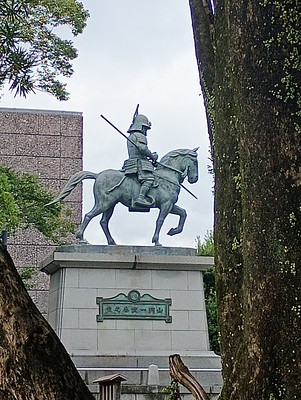Yamauchi Kazutoyo

Yamauchi Kazutoyo was the first Edo period daimyô of Tosa han, and a general under Oda Nobunaga, Toyotomi Hideyoshi, and later, Tokugawa Ieyasu, leading troops in several of the most major battles of the closing decades of the Sengoku period.
Kazutoyo was from Owari province and was the son of Yamauchi Moritoyo, who died in battle in 1559 when Kazutoyo was fourteen. After wandering as a ronin for a time, he came into the service of Oda Nobunaga from about 1565 until the latter's death in 1582, leading troops at Anegawa and Nagashino. He continued to serve under Toyotomi Hideyoshi as he had previously, and was awarded a 400 koku domain in Karakuni, later being transferred to Nagahama in Ômi province. Following the Odawara Campaign and the Tokugawa transfer to the Kantô in 1590, Kazutoyo received the 50,000 koku fief of Kakegawa in Tôtômi province (near Shizuoka); the fief was later expanded to 60,000 koku. Kazutoyo sided with Tokugawa Ieyasu in the Sekigahara Campaign (1600) and assisted in the capture of Gifu castle, leading 2,000 men in the rear guard at the Battle of Sekigahara. Though the size of his military contribution to the campaign was not particularly considerable, Kazutoyo was one of the chief former Toyotomi retainers who willingly offered to give up all his territory to the Tokugawa, and was thus warmly rewarded for his exceptionally loyal service, being given the domain of Kôchi in Tosa province.
A group of unruly former Chôsokabe retainers, including rural samurai called ichiryô gusoku, resisted the Yamauchi transfer, holing up in the castle of Urado, firing upon envoys of the Tokugawa, and insisting that Chôsokabe Morichika be permitted to keep at least half his domain, as other lords had successfully negotiated to do. Ieyasu sent forces to help Kazutoyo take the castle, and with the help of Ii Naomasa, Suzuki Hyôe, and others, including a number of senior Chôsokabe retainers who opened the gates to the castle, the Yamauchi were able to take the castle and claim control over the domain. As a result of his reliance on Ieyasu's aid in pacifying the domain, the Yamauchi remained considerably indebted to the Tokugawa in the early stages of the Edo period; the violent way in which Kazutoyo toppled the Chôsokabe, however, led to tensions with the samurai and other people of Tosa for some time to come. Following Kazutoyo's personal arrival in the domain on 1601/1/2, many Chôsokabe retainers were banished from the domain and became ronin, while others were executed by the Yamauchi; a few rural samurai were allowed to retain their land and status, becoming gôshi, but many other rural samurai, while permitted to keep their land, were stripped of their samurai status, becoming peasants, albeit prominent ones, with many becoming village elders or headmen.
Tosa leaders calculated the domain's kokudaka based on Chôsokabe cadastral surveys, reporting a figure just above 200,000 koku to the Tokugawa shogunate in 1604; this figure would become the domain's official kokudaka for the remainder of the period. Kazutoyo dispersed lands to his retainers, retaining roughly 45,000 koku worth of land for himself, and granting the castle of Nakamura and land worth 20,000 koku to his brother Yamauchi Yasutoyo, while another set of lands, ranging in value from 1100 to 10,000 koku and each centered at a castle, were granted to five of his most senior retainers. Roughly one hundred lower-ranking samurai each got fiefs ranging from 20 koku to 7,000 in value, along with residences in Kôchi, while the remaining lower-ranking retainers received stipends but no land in fief. As most of Kazutoyo's retainers were not originally from Tosa, but had come with him from Honshû, they had no fiefs to be removed from, and so most were able to be easily concentrated in the new castle town of Kôchi, where they were provided with residences. Even those who were granted fiefs elsewhere in the domain were, in most cases, given collections of spots of land scattered across a number of villages; these could serve to provide the retainer with tax income, but were intentionally not well-suited to become powerful local bases of power.
Kazutoyo died in 1605, and was succeeded as lord of Tosa by his nephew Yamauchi Tadayoshi.
| Preceded by: None |
Lord of Tosa han 1600-1605 |
Succeeded by: Yamauchi Tadayoshi |
References
- Initial text from Sengoku Biographical Dictionary (Samurai-Archives.com) FWSeal & CEWest, 2005
- Luke Roberts, Mercantilism in a Japanese Domain: The Merchant Origins of Economic Nationalism in 18th-Century Tosa, Cambridge University Press (1998), 33-40.
- ↑ The family name is sometimes rendered alternatively as Yamanouchi instead of Yamauchi; the given name, similarly, is alternatively Kazutoyo or Katsutoyo.